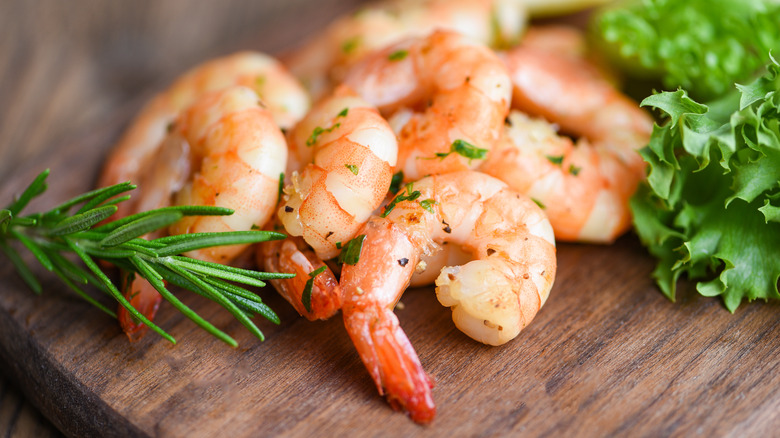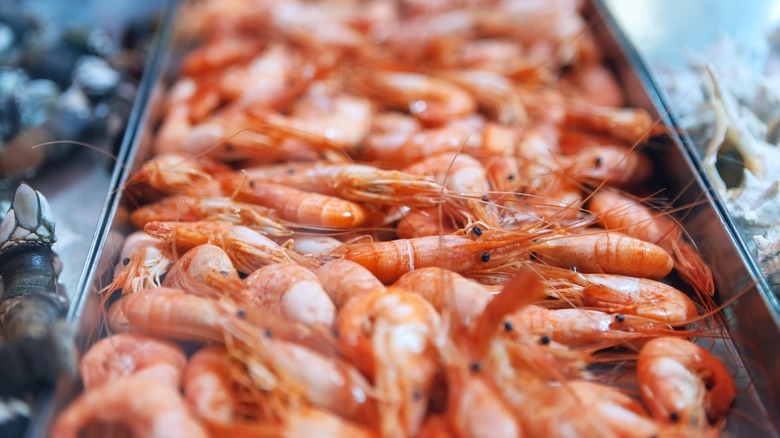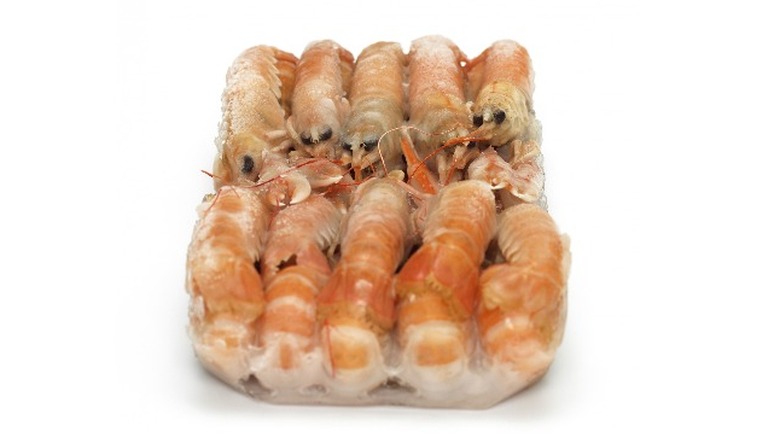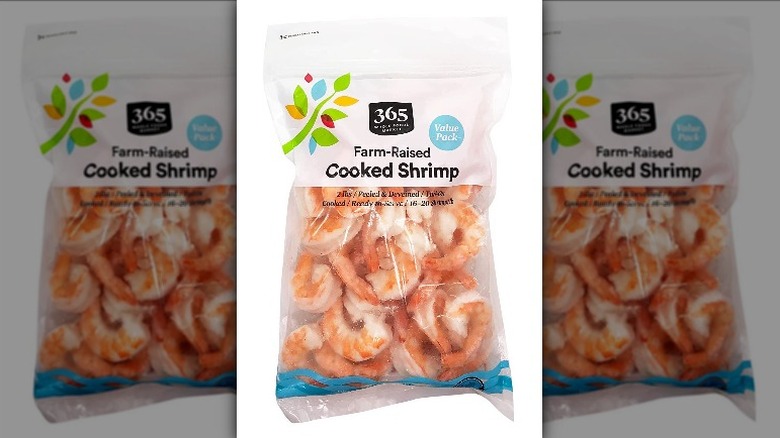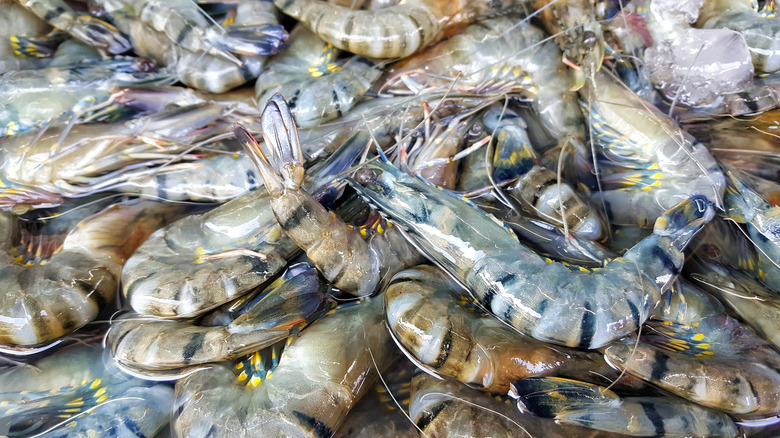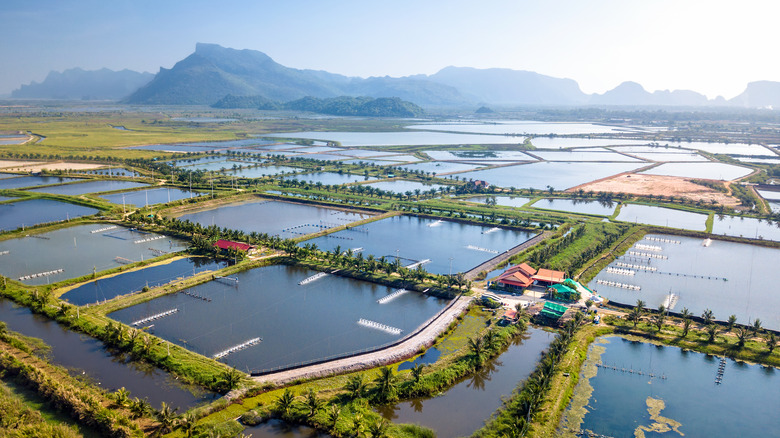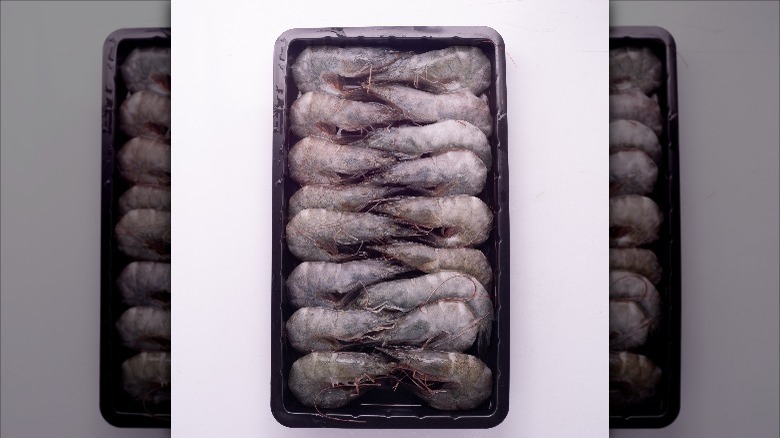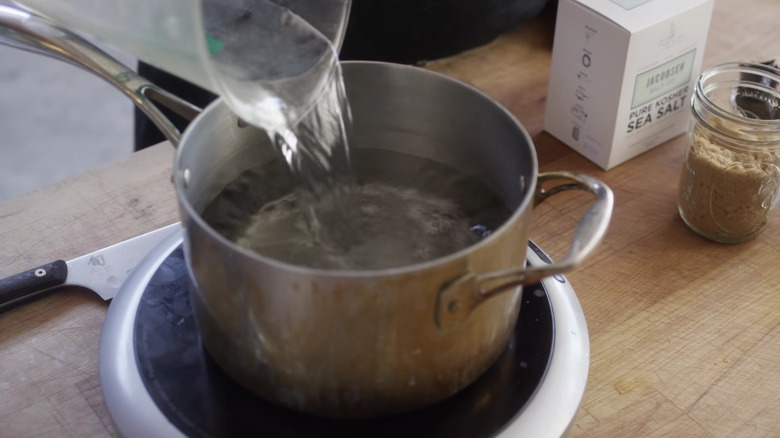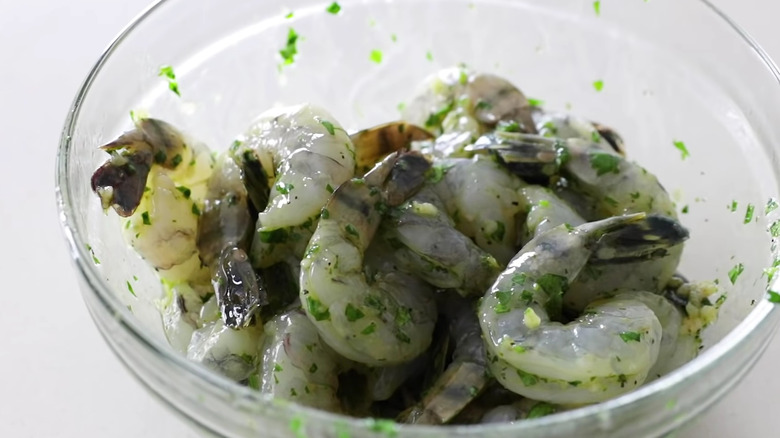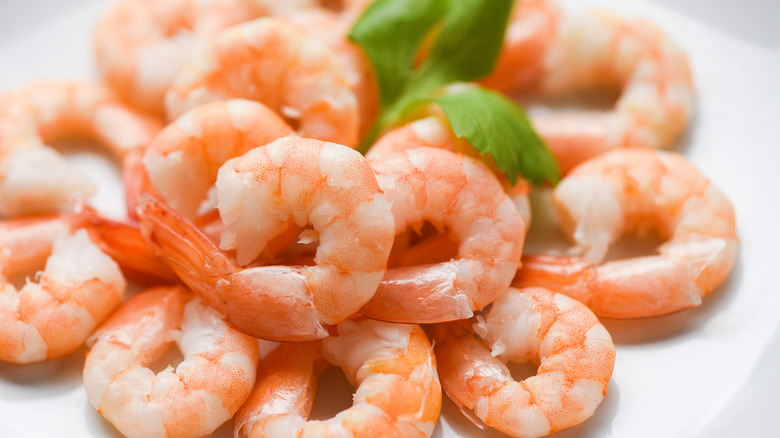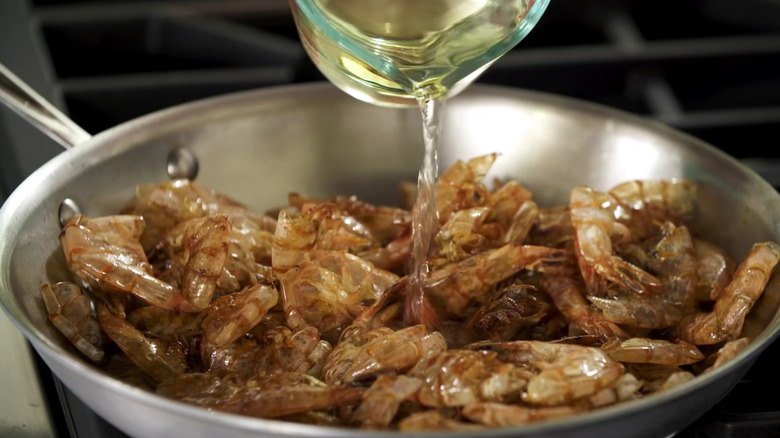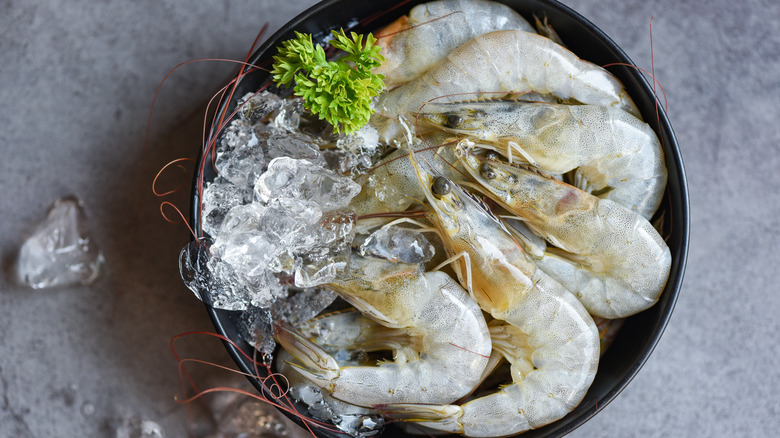12 Mistakes You Need To Avoid With Shrimp
Once a seasonal delicacy reserved for fine dining establishments, shrimp has become a fixture in both restaurant and home kitchens alike. Slate reports this swing in usage was the result of a farming revolution that enabled the production of shrimp on an industrial scale. This abundant, cheap, and year-round source of shrimp led American consumption of the crustacean to boom following the turn of the 21st century. Today, shrimp stands as the most popular seafood in America, with each U.S. citizen eating, on average, 4.6 pounds of shrimp per year, as per NOAA Fisheries (via Seafood Source).
Despite being so widely consumed, shrimp are often poorly sourced, prepared, and cooked by Americans. This is by no means the fault of the populace. As is the case with a lot of seafood, the vast majority of shrimp are imported to America (via Oceana), while obscure labeling makes it difficult for consumers to make informed choices, as per The Guardian. The waters remain muddied when it comes to shrimp preparation and cooking, with opposing views being espoused across the mediascape. So, in order to add some clarity to your shrimp-based endeavors, we have collated the 12 biggest mistakes people make when purchasing, prepping, and cooking shrimp. Avoiding these mistakes won't guarantee you perfect shrimp every time, but they are a fantastic place to start.
Buying fresh shrimp
Truly fresh shrimp, which is either alive or has just been caught in the past few hours, is a rarity, as Gerard Viverito, a processor of culinary arts, explained to Consumer Reports: "In a perfect world, shrimp would be bought fresh and used as such ... Unfortunately, due to shipping, they are frozen because of their extremely high perishability." This means that the majority of non-frozen shrimp being sold in the nation's supermarkets are not fresh at all, but actually pre-frozen shrimp that have been thawed. As Escoffier School of Culinary Arts notes, this unnecessary thawing process only damages the quality of the shrimp and fast tracks the spoiling process, leading us to the conclusion that the best and freshest option for most Americans is to buy frozen shrimp. Frozen, however, does not always mean fresh. Livestrong highlights that consumers should be wary of frozen shrimp that are bendable, smell overly fishy, and contain signs of freezer burn, as all are signs of spoilage.
If you live near shrimping hotspots, such as the Gulf Coast, you can probably assume the fresh shrimp you are purchasing were caught that day. Even if this is the case, it is important to remember that shrimp spoil incredibly quickly, especially if their heads are left on (via BC Live Spot Prawns). With that in mind, you should aim to cook that fresh shrimp within a day for best results.
Choosing block frozen shrimp over IQF
As previously mentioned, the vast majority of Americans should be purchasing frozen shrimp. Yet, the choices do not end there. Prospective shrimp buyers will also have to decide whether to choose block frozen shrimp or individual quick-freezing shrimp, known in the industry as IQF (via Martak). Fortunately, the consensus on this choice is fairly universal, with IQF shrimp having a number of advantages over their block frozen counterparts.
Chief among these is that the shrimp lose less water during the freezing process when the IQF method is used. This not only translates into a juicier shrimp ending up on your plate, but also limits the amount of freezer burn and other damages that can occur during storage, as per Arico. Furthermore, the fact that shrimp are frozen individually means that, despite typically being stored alongside others in a bag, it is easy to remove and thaw exactly how many shrimps you need. By comparison, the nature of block frozen shrimp means that the whole packet must be thawed, even if only a few are needed.
Purchasing pre-cooked shrimp
Many grocery stores offer shrimp that has been cleaned, prepared, and fully cooked. Nearly all commercially available pre-cooked shrimp has been boiled in vats of lightly salted water, before being cooled, peeled, and eventually packaged, as per the UN Food and Agriculture Organization. At home, this product only requires thawing before it is ready to eat, which has made it a favorite among time-pressed party hosts.
While pre-cooked shrimp is suitable for adding to cold dishes, such as salads and prawn cocktails, you should avoid including them in any recipe that will require a lot of further cooking (per Livestrong). Since the shrimp is already cooked, adding it during the cooking process, or even to hot food, can very quickly lead to the shrimp becoming overcooked and rubbery (via Southern Living). With that in mind, freshly frozen shrimp should nearly always be purchased in the place of pre-cooked, unless time is extremely short.
Selecting the wrong type of shrimp
It's important to realize that the word shrimp is an umbrella term for over 3,000 different species of crustacean, according to The Fish Society. While the vast majority of these are not consumed by humans, there are still numerous options to choose from when purchasing shrimp. Each of these species have unique characteristics that make them well-suited for distinct culinary practices. As chef Chris Hastings put it to Alabama Gulf Seafood, "Shrimp are thought of almost as a commodity ... But they each have their own characteristics and flavor profiles. I would challenge people to think of shrimp differently, not just as 'all shrimp are created equal.' Because they're not." The same source highlights the huge variety of shrimp that can be found off America's Gulf Coast alone, along with all their unique uses. For example, brown gulf shrimp are suited to stews and gumbos while royal red shrimp are best served alone.
If we expand our palate to include shrimp from around the world, as is only appropriate given America's mass importation of the seafood, then it becomes clear that there is a shrimp suited to every kind of dish. While whole books could be filled with this information, for novices, the best place to start is with size. As Southern Living highlights, smaller shrimp are best suited to when the crustacean plays a supporting role. On the other hand, larger shrimp are better when they are the focus of the dish.
Using unsustainable shrimp
According to the World Wildlife Fund, over half of the world's shrimp are now farmed — a fact that would have been inconceivable 40 years ago when shrimp farming was a practice rife with seemingly unsolvable challenges (via Slate). Farming has been responsible for both the global abundance of shrimp and the associated drop in price. Unfortunately, these practices have also had a telling effect on the natural environment and many humans' lives.
The Guardian reports that on both a social and environmental level, intensive shrimp farming has been disastrous for Bangladesh. Many crop farmers transitioned to shrimp in response to climate change which had led to repeated flooding of agricultural land. Unfortunately, disease, storm damage, and gang-like monopolies have all meant that the average farmer has gained little from this transition. Meanwhile, fertilizer and tainted runoff water has leached into nearby agricultural sites and poisoned drinking sources. The Cornucopia Institute highlights that these problems are not unique to Bangladesh, with other shrimp farming countries like Thailand and India also suffering from mass environmental issues caused by shrimp farming.
With the accurate tracing of seafood being notoriously difficult (via The New York Times), one of the best ways for Americans to ensure their shrimp is sustainable is to buy crustaceans caught in American waters. Many of these domestic shrimp producers use certifications to validate their sustainability, giving buyers a guarantee of quality and sustainability, that other options lack.
Not thawing correctly
With the majority of us having little choice but to purchase frozen shrimp, knowing the correct thawing procedure is of tantamount importance. Failure to thaw properly can have dire consequences. As High Speed Training notes, not thawing your shrimp fully can extend the required cooking time, elevating the risk that people are consuming undercooked shrimp. And Consumer Reports found that 60% of imported shrimp are riddled with harmful bacteria, such as salmonella, meaning that incorrect cooking can potentially cause serious illness.
On the other hand, leaving shrimp to thaw for too long can result in its internal temperature rising to reach the danger zone — between 40 degrees F and 140 degrees F — the point that harmful bacteria can rapidly multiply, according to the Food and Drug Administration.
Fortunately, there are several ways to safely and uniformly defrost shrimp. The most popular method is to place your frozen shrimp in the refrigerator overnight (via Southern Living). For a quicker means of defrosting shrimp, the FDA advises immersing a sealed bag of shrimp in cold water. IQF shrimp have an advantage in that they can be cooked directly from frozen, as Enterprise Podcast Network reports. However, this is thought to damage the flavor and texture of the crustacean, as per The Express.
Failing to prepare your shrimp properly
Before cooking can take place, you need to prepare your shrimp. How you do this depends largely on what you are using the shrimp for. If you are going to be cooking them in a rich, flavorful sauce, such as that used in the popular Spanish tapas dish, gambas al ajillo, it would be advisable to remove shells so the flesh can soak up as much flavor as possible (per The Guardian). Removing the shell also provides you with an opportunity to devein the shrimp. Simply cut a small slice into the back of the shrimp and tease out the dark digestive tract with the tip of your knife. This will ensure that no sand, grit, or mud ruins your dining experience (via The Washington Post).
On the other hand, leaving the shells on can have some benefits. Today reports that cooking shell-on shrimp results in an extra dimension of flavor while also protecting the flesh from overcooking. This makes it an ideal option for when you plan to cook the shrimp on a direct heat source like a grill. Either way, be sure to handle the raw shrimp away from any other food source to minimize the risk of cross contamination occurring (via Centre for Food Safety).
Forgetting to brine
According to the Food and Agriculture Organization, shrimp lose 26% of their mass within three minutes of cooking. While some water loss is to be expected, this dramatic reduction in a shrimp's weight can result in a cooked crustacean that is small, dry, and tough. A far cry from the plump, juicy shrimp we all desire. In order to prevent water loss during cooking, chefs often turn to a simple method known as brining.
Great British Chefs reports that brine is basically salt water — although other ingredients can be added — which the shrimp is soaked in before cooking. The salt draws more water into the shrimp's flesh and subsequently traps it there by denaturing the proteins, ensuring the shrimp retains its moisture during cooking, as per Cook's Illustrated. And thanks to shrimp being so small, they do not require much time in a brine. You'll need less than an hour for the process to take place (via What's Cooking America).
Marinating for too long
In an effort to add extra flavor to shrimp, many people marinate them before cooking. If you choose to do this, it's very important to factor in the type of marinade you're making, and how long you plan to let it sit, especially when acidic ingredients are involved. This is because shrimp, like pretty much all seafood, is extremely vulnerable to acid — a fact exemplified by ceviche, a classic Peruvian dish that involves "cooking" seafood in lime juice.
As SBS notes, the acid affects the flesh's protein structures much like traditional cooking does, causing it to soften while also killing potentially harmful bacteria. While this is desirable when making ceviche, shrimp that are left in an acidic marinade will also begin to denature. If left in the marinade for any longer than 30 minutes, the shrimp's texture will become mushy, as per the City Fish Market. It's an unappetizing texture that you will not be able to rectify.
Overcooking shrimp
Without a doubt, the most common shrimp-based mistake made by cooks, amateur and professional, is overcooking. Admittedly, it is a very easy thing to do; shrimp are usually quite small and tend to cook in a matter of minutes (via Southern Living). That is why attentive watching and quick removal from the heat is of paramount importance. Some chefs, such as Nelson German, even advise initially undercooking shrimp: "A little tip is when you take it off the pan, say a beautiful fish or shrimp, it's going to keep cooking because it's a delicate piece of meat, or protein ... Be aware that once you take it off, it's still cooking."
As shrimp are so prone to overcooking, it is best to avoid using intense heat sources such as grills to cook them (via The Daily Mail). Alternative methods, like sauteing in a pan, give the cook more control over temperature and cooking times. According to Southern Living, cooks should be watching for a uniform pink color, which indicates the shrimp are perfectly cooked. The shrimp should then be taken out of the hot pan immediately and allowed to rest. Failure to do so may result in the flesh turning an opaque white and the shrimp curling up tightly, both of which are tell-tale signs that the flesh is overcooked.
Discarding the shells and heads
While not as detrimental as overcooking the shrimp themselves, discarding the shrimp's exoskeleton, along with the head, is a big mistake. To put it simply, there is an incredible amount of flavor locked up in these parts of the animal, and it is a real shame to throw this away without utilizing it. Doing so is quite simple — make some stock. Simply roast the shells before adding aromatics, vegetables, and water, and simmer it all for a few hours. Great British Chefs highlights that this is a fantastic way to maximize your usage of the animals and get your money's worth. What's more, the stock you create will be far healthier than store bought stock, which tends to have a high salt content, per the American Diabetes Association.
Alternatively, The Guardian advises deep frying shrimp heads and shells, a cooking process that allows them to be eaten with ease. This is a practice common in Japan, where the deep fried heads are seen as a perfect accompaniment to beer in izakaya establishments.
Getting caught up with shrimp's cholesterol content
It has been widely reported that shrimp contain high amounts of cholesterol — 161 mg per 3 ounces (a single serving) of raw shrimp, according to the USDA. To put this into perspective, the daily recommended intake of cholesterol is only 300 milligrams, as per UCSF Health. This may put off some consumers, especially those who already have high cholesterol or are predisposed to heart disease, from eating shrimp, as it has long been thought that foods rich in cholesterol elevate the one's own blood cholesterol levels when consumed.
However, as Livestrong notes, in recent years, concerns over dietary cholesterol intake have dropped somewhat as studies have revealed the vast majority of blood cholesterol is not affected by diet. As shrimp is low in trans-fats and rich in antioxidants (via Healthline), they can now be viewed as an important part of a healthy diet, much to the relief of shrimp lovers across the world.
